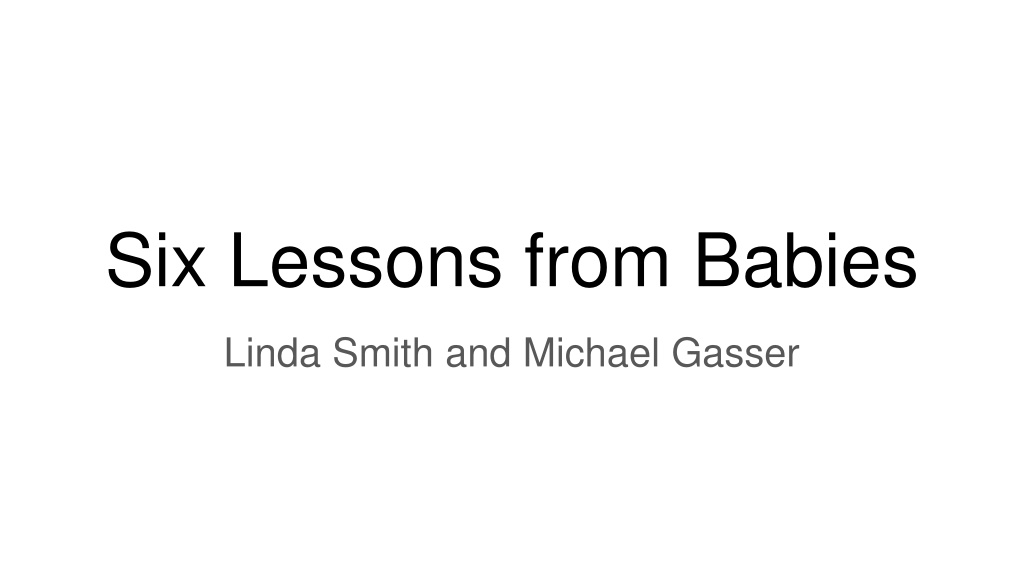
Insights from Babies: Lessons in Development
Explore the fascinating world of infant development through the lens of six key lessons, including being multi-modal, incremental, physical, explorative, social, and language learners. Discover how babies educate themselves through sensory systems, experience with transparent objects, responses to auditory and visual stimuli, and self-locomotion behaviors. Witness the incremental growth and changing capabilities of infants as they interact with their environment in unique ways.
Download Presentation

Please find below an Image/Link to download the presentation.
The content on the website is provided AS IS for your information and personal use only. It may not be sold, licensed, or shared on other websites without obtaining consent from the author. Download presentation by click this link. If you encounter any issues during the download, it is possible that the publisher has removed the file from their server.
E N D
Presentation Transcript
Six Lessons from Babies Linda Smith and Michael Gasser
6 Lessons 1. Be Multi-model 2. Be Incremental 3. Be Physical 4. Explore 5. Be Social 6. Learn a Language
1. Be Multi-Modal Babies experience of the world is profoundly multi-modal. We propose that multiple overlapping and time-locked sensory systems enable the developing system to educate itself without defined external tasks or teachers just by perceiving and acting in the world. Vision Haptics
Transparent Objects 9 month old babies are better at retrieving object from opaque box than from the transparent box. Infants who played with the transparent containers: sought out and rapidly found the openings and retrieved the object from the transparent boxes.
Tucker and Ellis task Is this a pitcher? Yes No Yes No No Yes No Yes Faster response, when Yes button is on the same side as the handle.
2. Be Incremental - Babies develop incrementally, and they are not smart at the start. We propose that their initial prematurity and the particular path they take to development are crucial to their eventual outpacing of the world's smartest AI programs. - Experience of babies changes over time as their capabilities increase.
Audition and Vision - Infants look in the direction of sound. - Infants look at visual events that match what they hear. - Children without audition show altered and more disorganized visual attention.
A-not-B and Self-Locomotion Children that have self-locomoted reach for where the toy is hidden as opposed to children who haven t yet self-locomoted who search where they searched before.
Ordering Matters - Opening kittens eyes early disrupts olfactory development and the subsequent coordination of vision and olfaction. - Disrupting the developmental order of audition and vision in owls disrupts spatial localization in both modalities.
3. Be Physical Babies live in a physical world, full of rich regularities that organize perception, action, and ultimately thought. The intelligence of babies resides not just inside themselves but is distributed across their interactions and experiences in the physical world. The physical world serves to bootstrap higher mental functions.
3. Be Physical - People routinely and apparently unconsciously gesture with one hand when speaking of one protagonist in a story and gesture with the other hand when speaking of a different protagonist. - People also use space as a mnemonic, looking in the direction of a past event to help remember that event. (Hollywood Square experiment)
4. Explore Babies explore they move and act in highly variable and playful ways that are not goal-oriented and are seemingly random. In doing so, they discover new problems and new solutions. Exploration makes intelligence open-ended and inventive.
4. Explore - Reaching: Different babies go about learning how to reach objects in different ways. - Infant Conjugate Reinforcement: Infants increase kicking above baseline levels (where they don t control the mobile toy).
5. Be Social Babies act and learn in a social world in which more mature partners guide learning and add supporting structures to that learning.
5. Be Social - Mothers facial gestures and the sounds they make are tightly coupled to the babies behavior. - Parents provide the structure for learning by imitating their babies. - Parents introduce objects, call out their names, shake them to make babies attend to them.
6. Learn a language Babies learn a language, a shared communicative system that is symbolic. And this changes everything, enabling children to form even higher-level and more abstract distinctions.
6. Learn a language - Gain direct access to knowledge of other people. - Explicit categorization and generalizations for supervised category learning. - Language learning may be key to becoming symbolic.
6. Learn a language - Languages are symbol systems: symbols are abstract. Most words by themselves do not indicate what we are referring to. - Infact, if symbols are too close to the actual world, they aren t used as symbols. - It has long been suggested that the way into symbolic processing is through language, and though this idea remains controversial, we believe it is worth taking seriously.
6 Lessons 1. Be Multi-modal 2. Be Incremental 3. Be Physical 4. Explore 5. Be Social 6. Learn a Language
Discussion Think of 2 examples among papers we have read in class that operationalize these insights Think of 2 ways, not covered in class, in which we can invoke insights from this paper
